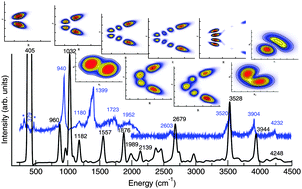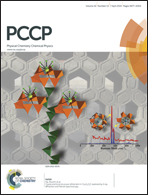Theoretical predictions on the role of the internal H3+ rotation in the IR spectra of the H5+ and D5+ cations
Abstract
The IR spectra of the H5+ and D5+ cations in the mid- and far-IR spectral regions have been recently reported by experimentalists. These spectra show very rich vibrational patterns representing a challenge for state-of-the-art theoretical methods to provide definitive interpretations of them. Using a full-dimensional quantum anharmonic treatment, within the MCTDH approach, together with ab initio potential and dipole moment surfaces, the predominant features in the spectra are assigned, completing an important part in previous theoretical and experimental comparisons. The internal rotation of the H3+ unit by exciting the H3+–H2 stretching mode is found to correspond to the new calculated features at 1182, 1876, and 2139 cm−1 of the H5+ spectrum, leading to a consistent assignment with the experimental spectra. In the calculated spectra of both H5+ and D5+ clusters, the progressions in the H3+–H2 stretch of the shared proton and the in- and out-of- plane H3+ rotation are demonstrated to be the main features. Such states are expected to play a central role in the low temperature hydrogen/deuterium proton hop/exchange H3+ + H2 reactions.


 Please wait while we load your content...
Please wait while we load your content...